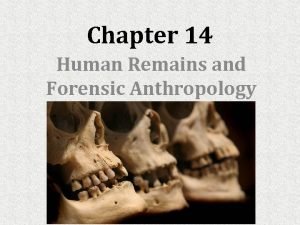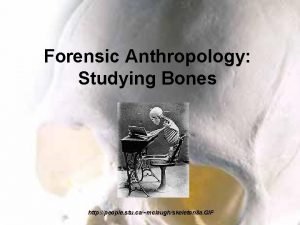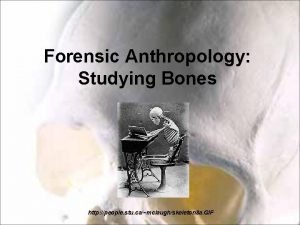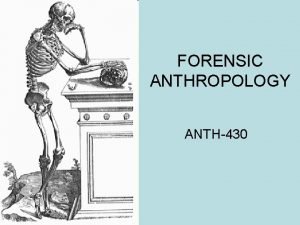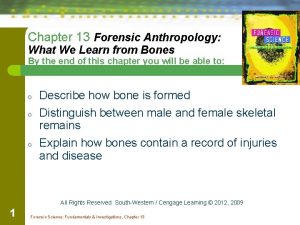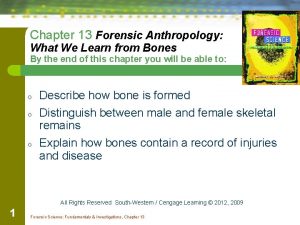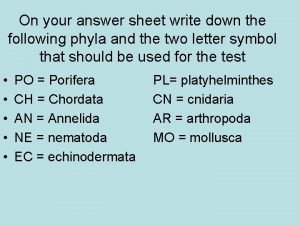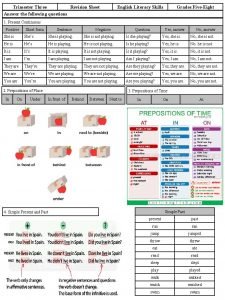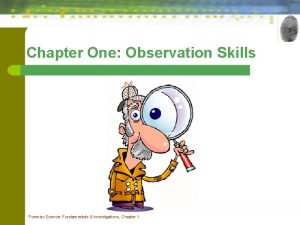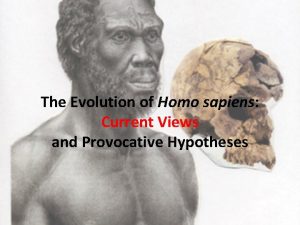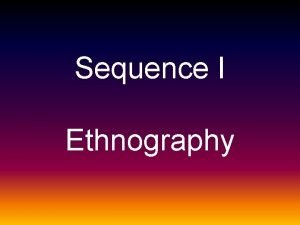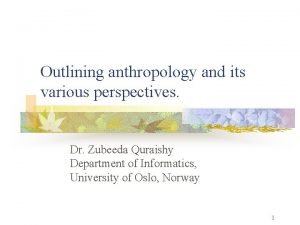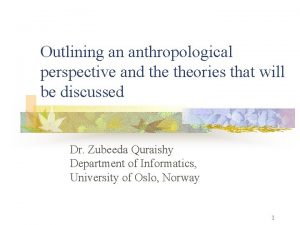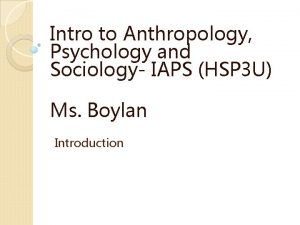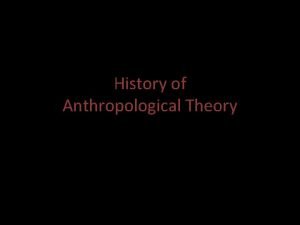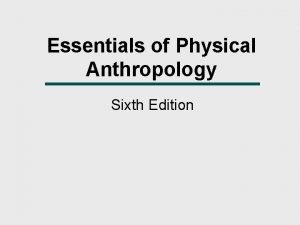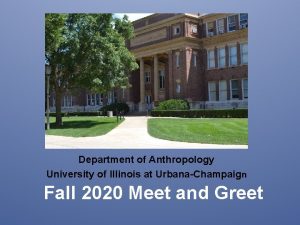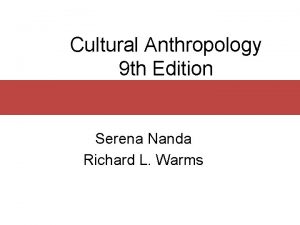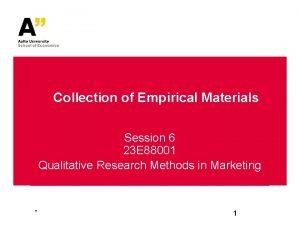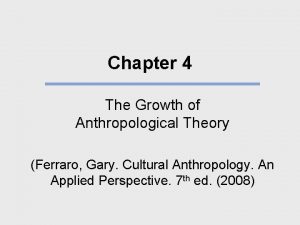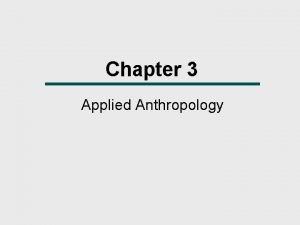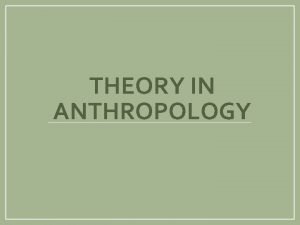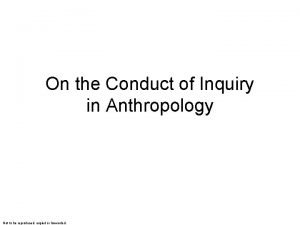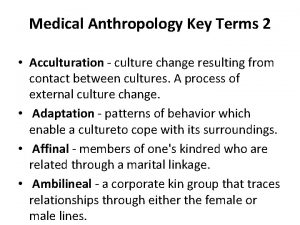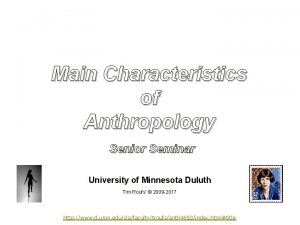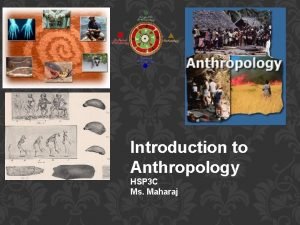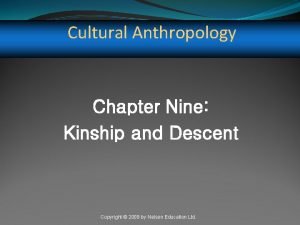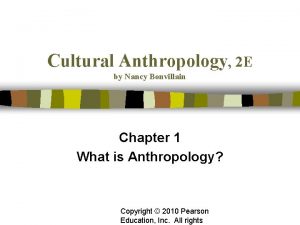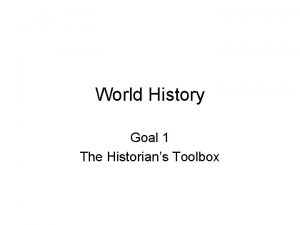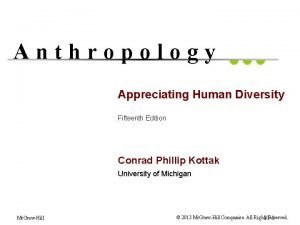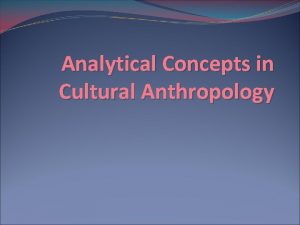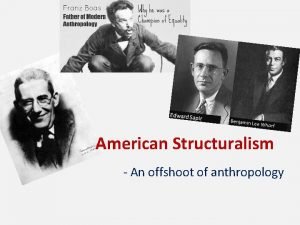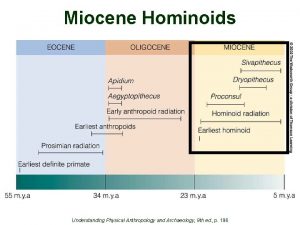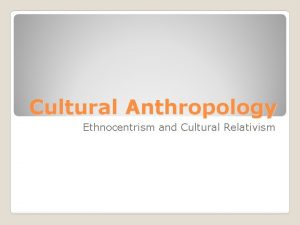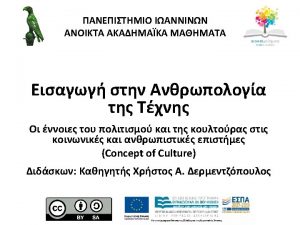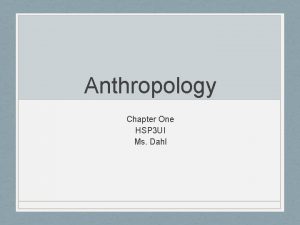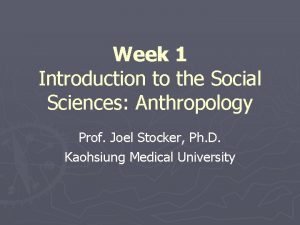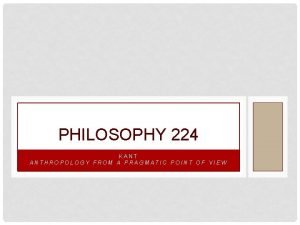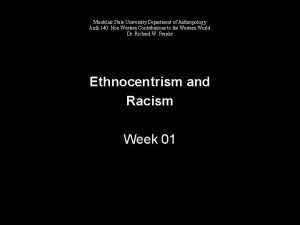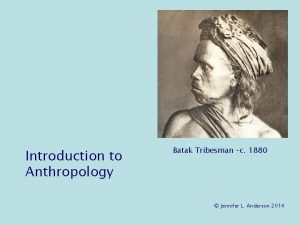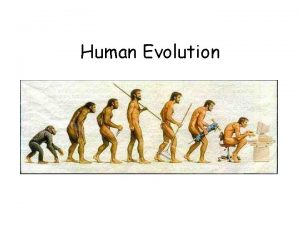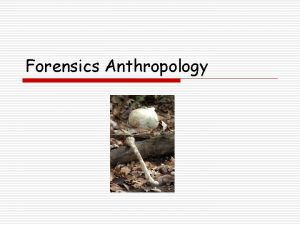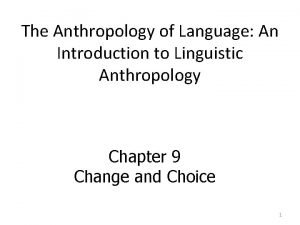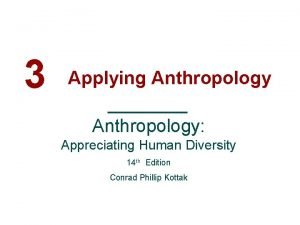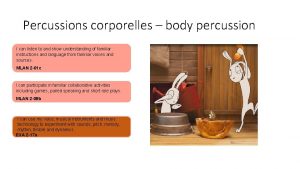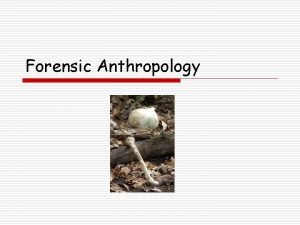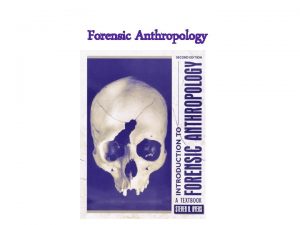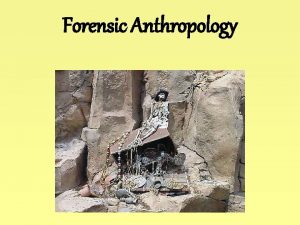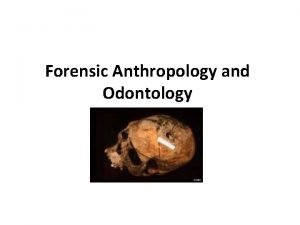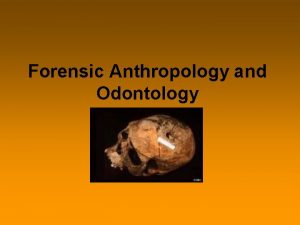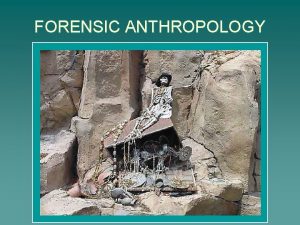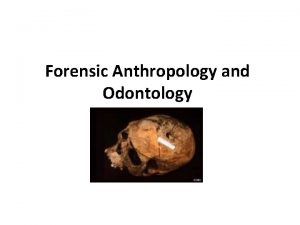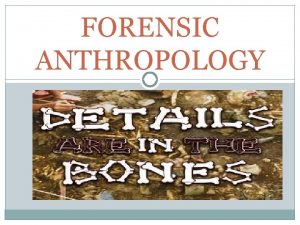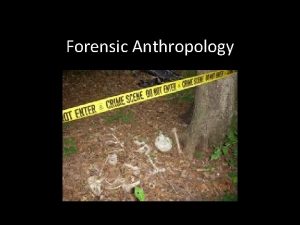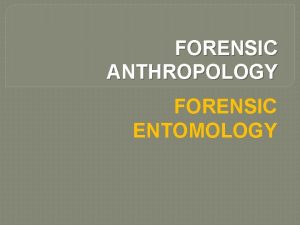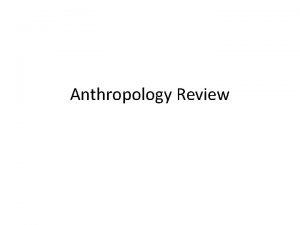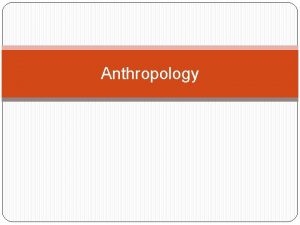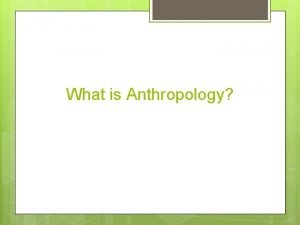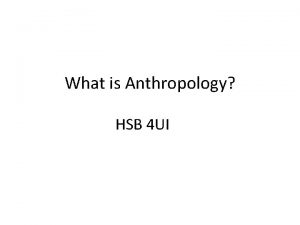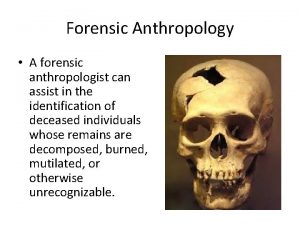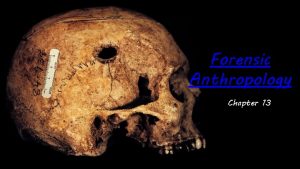Forensic Anthropology What Questions Can Forensic Anthropology Answer













































































- Slides: 77

Forensic Anthropology

What Questions Can Forensic Anthropology Answer? • • Race Sex Approximate age Approximate stature Pathologies (diseases) Traumas (injuries) Other individual traits

Identity of Decomposed or Skeletal Remains • Are the remains human or animal? (butchers remains and skeletal remains of dead pets etc. may be found in unlikely places) • Are they really bones? (wood, stones) • How many bodies? • How long dead? - recent or ancient (e. g. construction or digging at an old burial site) • Cause of death?

How does this Work? • Regression equations used to determine sex, age, stature, and race of skeletal remains. • Regression equations are mathematical equations developed from studies of bones of individuals of known sex, age, race, and stature, and are used to predict such things of even fragmentary skeletal remains. "

Sex Estimation • The sex of an individual is determined, when soft tissue is not present, by a number of skeletal indicators. • The more indicators used to determine sex, the more accurate the results. • A forensic anthropologist is analytically limited by the bones present and the condition of the bones.

• Bones of men are larger and more robust than bones of women. • Some bones display specific features which can be used to help determination of the sex of the skeleton. The best indicators are the: – Skull – Pelvis – Head of the Femur

Sex Estimation – long bones • Usually related to size in adult long bones • Male bones: usually larger, longer in a single population – be cautious if different populations are involved • Maximum diameter of head of humerus and head of femur may be used (Bass). • Much more difficult to estimate sex in children’s skeletons.

Head of the Femur • In men, the diameter of the head of the femur is larger than 51 mm. • In women, the diameter of the head of the femur is less than 45 mm.

Other femur features

Sex Estimation: Skull • Good area for sex determination • Generalization: male skull more robust, muscle-marked than female, but ABSOLUTE DIFFERENCES SELDOM EXIST • Sex estimation: face, mandible, vault

Sex Estimation: Face 1. Supraorbital (Brow) ridges: more prominent in males 2. Superior orbital margin: sharper in females 3. Palate: larger in males 4. Teeth: larger in males 5. Mastoid process: more prominent and rugged in males. 6. Orbit (Eye socket): Rounder in females, more rectangular in males 7. Chin: more pronounced in males and larger jaws.





Pelvis • The pelvis of a woman is wide and circular whereas the pelvis of a man is narrow and heart -shaped. • Two angles, the sub-pubic angle and the sciatic notch, cause the differences in the shape of the pelvis. • In women, the sub-pubic angle and sciatic notch are wide. In men, the sub-pubic angle and sciatic notch are narrow.

Pubis Bone Traits Related to Sex Trait Ventral arc: a roughened projection of bone visible on the anterior surface of the pubis bone Pubis body width (mm) Subpubic angle (degrees) angle made by the inferior borders of the articulated pubis bone Female Male Present Absent 40 >90 25 -30 <90

Male Pelvis Subpubic Notch

Female Pelvis Subpubic Notch

Sciatic notch comparison – which is female?



Determining Ages of Skeletons • Bone growth stops at about 20 yrs. of age in humans. • Adult bone continuously adapts to prevailing stresses by appropriate deposition and resorption. • Deposition and resorption are under hormonal control - integrated with regulation of blood calcium levels.

Skeletal Age • Skeletal age is the estimated age at which a person died. Skeletal age can be determined by looking at the following: – sutures of the skull – teeth – ribs – vertebrae – growth areas of the long bones: epiphyses

Sutures of the Skull • When a baby is born, the skull is still growing. To accommodate this growth, the different bones of the skull are separate. • By the age of 7, all the different bones have finished growing and the fontanelles have disappeared. • Most sutures begin fusing no earlier than 18 years of age


Skull Sutures


Fused sutures in adult

The Teeth • The teeth are arranged in upper and lower arches. Those of the upper are called maxillary; those of the lower are mandibular.

• There are four types of teeth with very different shapes: • Incisors (2) • Canines (1) • Premolars (bicuspids) (2) • Molars (2 -3) • Individual teeth are quite distinct, even when lost from a jaw.

Dental Formula (from the midline) • Primary (deciduous) teeth. – incisors, two upper and two lower; – canines, one upper and one lower; – molars two upper and two lower equals ten per side. • Permanent teeth. – incisors, two upper and two lower; – canines, one upper and one lower; – premolars, two upper and two lower; – molars, three upper and three lower.

Teeth • The first teeth to appear are the incisors, which are followed by canines and molars. • When chewing food, teeth grind down. • Comparing different teeth gives an idea of how long the teeth have been used. • Eventually teeth may be lost, due to caries or attrition.

X-Rays Are Used to Date Skulls • This is the side view of the dentition of a six year old boy. • There is still some variation from person to person in the order in which the teeth erupt.

Baby Teeth Permanent Teeth Incisors: 7 -12 months Incisors: 6. 5 years Canines: 2 years Canines: 10. 8 years Premolar 1: none Premolar 1: 10. 4 years Premolar 2: none Premolar 2: 11 years Molar 1: 3 years Molar 1: 6. 2 years Molar 2: 3 years Molar 2: 12. 2 years Molar 3: none Molar 3: 18 years

Baby Teeth with 12 year Molars Teeth with 6 year molars Teeth with Wisdom Teeth


Dental Disease - Cavities, Abscesses, and Attrition

Ribs • Because of breathing, the front part of the ribs is constantly moving. • As a person gets older, the front part of the ribs begin to change and form bony spikes.

Vertebrae • As a person gets older, bony spikes can also start growing on the vertebrae. • This starts at approximately 40 years of age.

Growth areas of the long bones (epiphysis) • From birth to ± 25 years of age, a person grows at a relatively constant rate. • Growth takes place at the ends of the long bones. • At a certain age, growth is completed and this can also be seen on the bone.

Epiphyseal Fusion • The pattern of fusion of bone ends (epiphysis) to bone shaft (metaphysis) in each bone indicates age. • The upper arm stops growing at the shoulder at approximately age 20 and at the elbow at approximately age 14. 5. • The upper leg stops growing at the hip at approximately age 17. 5 and at the knee at approximately age 18.


Determining Ages of Skeletons • Cranial suture fusion is less reliable. • Pubic symphysis changes slightly with age. • Arthritic changes and osteoporosis give further clues.

Height • An intact corpse can be measured, but a disarticulated or incomplete skeleton has to be pieced together. • Stature • 3. 26 x (humerus) + 62. 10 = stature +/-4. 43 cm • 3. 42 x (radius) + 81. 56 = stature +/-4. 30 cm • 3. 26 x (ulna) + 78. 29 = stature +/-4. 42 cm – (there will be 2 calculations for stature, based on the upper and lower margin of error)

Race or Ethnic Group Determination • The skull is the only reliable bone. – Caucasoid (all whites) – Negroid (all blacks - African, African Americans and West Indians) – Mongoloid (Chinese, Japanese, American Indians)

In Caucasoids: Nasal openings are narrow. Face is flatter



In Mongoloids “Shovel-shaped" concave upper incisor teeth. Cheekbones (Zygomatic arches): are wider and more prominent. Greater width between eyes.




In Negroids: Face projects forward Nasal opening is wider



Comparison of the extent of ramus inversion in the mandible of an individual with caucasoid ancestry (top) and one with negroid ancestry (bottom)

Minimum Number of Individuals • Used in mass graves- like in Yugoslavia or Afghanistan and mass disasters. • Count all the bones and assign left vs. right. • Use the highest number of a bone as the minimum number. • Also, can assign bones to individual skeletons and then count them.


Dating of Human Skeletal Remains • Are they ancient or modern bones? (i. e. greater or less than 50 years). • Rate of skeletonization is highly variable. In the tropics a body can be reduced to a skeleton in 3 weeks. • Remarkable preservation of body is seen in acidic peaty soil • Thus, environmental conditions have to be taken into account.

2400 year old bog body from Denmark

Age of Human Remains • Naked eye appearance is unreliable: • Tags of soft tissue, periosteum, ligaments etc, indicate less than 5 years old. • Soapy texture of surface indicates age less than a few decades. • Light, crumbling bones are likely to be a century or more old.

Laboratory Tests Can Help • Immunological reaction between bone extract and anti human serum ceases within months of death. • If blood pigments are present bones are usually less than 10 years old. • Up to 20 amino acids may be identified in bones less than a century old. • Fluorescence of freshly sawn bone surface under UV light diminishes after 100 years. • New bones contain 4. 0 - 4. 5 gms% nitrogen; 2. 5 gms% indicates approximately 350 years. • Radioactive carbon dating indicates which century.

Taphonomy • Coined from the Greek words taphos, for "burial, " and nomos, for "law. " • Forensic Taphonomy : The Postmortem Fate of Human Remains • Skeletal trauma, decomposition, and dispersal of remains. • Weathering, a taphonomic process, is very useful in determining the elapsed time since death.

Facial Reconstruction • Skull can be scanned into a computer and "fleshed" by computer reconstruction to give likely facial appearance in life. • Unfortunately eye color, hair color and lips are independent of bony structure.

• Pearl was a female who died in her early forties approximately three hundred years ago. • She was Caucasian, of European ancestry and stood about 5'1". • Her dental health was extremely poor and she had lost 63 per cent of her teeth prior to death. She had no teeth on either side of her jaw. This was most important as the loss of those teeth would evidence themselves in the final reconstruction as sunken cheeks. Of her remaining teeth, the condition was poor and she had several abscesses. • During her lifetime, there are indicators that she also suffered from acute infections, rickets, sinusities, an upper respiratory infection, arthritis, and gout. Whew--all this in an era when aspirin didn't exist! • On the other hand, it was determined that she was very muscular, as the ridges on her long bones were very developed.


The artist utilizes proper tissue depth data determined by race, gender, and age. Artificial eyes are placed in the skull’s eye sockets, centered and at the proper depth. The tissue markers are glued directly onto the skull. Clay will be systematically applied directly on the skull, following the skull's contours; paying strict attention to the applied tissue markers.

Various measurements are made, and logged, to determine nose thickness/length, mouth thickness/width, and eye placement. Information such as geographic location of where the deceased lived, his or her lifestyle, and the various information provided to the artist by the Forensic Anthropologist and other professionals, is heavily relied upon when completing the reconstruction.

This woman had missing side teeth and a small jaw. Hair is added by applying clay or a wig. Various items (glasses, clothing, hats) may be applied to better accentuate the features of the individual. This method can be very successful.

Cause of Death • Anthropologists can distinguish between marks from the result of a weapon attack and those resulting from the gnawing and biting of bones by scavenging animals. • They can also determine the exact kind of weapon and animal, and they can tell if a wound is old or if it occurred at death. • They can be called upon to testify as to the type of weapon used (saw vs. knife).

Lizzie Bordon’s Father’s skull: Ax Whacked.

• Two outstanding cases of the use of forensic anthropology to successfully solve unsolved mysteries are the cases of Francisco Pizarro.

Pizarro conquered the Incas. • Pizarro was hated by the Peruvians because he was a brutal ruler. On June 26, 1541 (at age 66), he was stabbed to death by a crowd of angry subjects and in view of many witnesses (Dickerson 1993). • His brutal death is not questioned due to the well documentation at the time. It was his remains that were questioned.

• In the 1890's, Peruvian officials decided to put Pizarro's remains on exhibit. "They asked officials at the Cathedral of the Plaza de Aramis in Lima for Pizarro's body and were directed to a mummy, which they put on view. " (Dickerson 1993) • In 1978 workers discovered a secret niche that had been walled over in the cathedral, and on a shelf in the niche was a box with a skull and an inscription that identified it as the head of Pizarro. • Another box was found containing the bones of several unidentified individuals (Dickerson 1993).

The Question was, "Who was the real Pizarro? " • An investigation of the bones in the second box led to the discovery that the postcranial bones matched the skull in the first box. • These bones and the skull were then placed together and prepared for study to determine if they had marks consistent with sword or knife wounds.

Who’s the Mummy? • Just by using visual observation, researchers could tell that the skeleton had been stabbed many times, dying in the same way as Pizarro was reported to have died. • The location of the wounds showed that the victim had been stabbed "about the head and body and apparently had tried to shield himself with his arm, a reaction common in stabbing deaths. " (Dickerson 1993) • On the other hand, the mummy had no such injuries at all (Dickerson 1993).
 Forensic anthropology unit
Forensic anthropology unit Forensic anthropology
Forensic anthropology Nasal silling/guttering
Nasal silling/guttering Forensic anthropology race determination
Forensic anthropology race determination Forensic anthropology data bank
Forensic anthropology data bank Chapter 13 forensic anthropology
Chapter 13 forensic anthropology Chapter 13 forensic anthropology
Chapter 13 forensic anthropology Thomas mocker and thomas stewart
Thomas mocker and thomas stewart Forensic psychiatry vs forensic psychology
Forensic psychiatry vs forensic psychology In your answer sheet answer the following questions
In your answer sheet answer the following questions In your answer sheet answer the following questions
In your answer sheet answer the following questions What is the answer
What is the answer Work in pairs and discuss the questions why do you think
Work in pairs and discuss the questions why do you think Why are observation skills important to forensic science
Why are observation skills important to forensic science What is anthropology
What is anthropology Lumpers and splitters anthropology
Lumpers and splitters anthropology Thick description anthropology
Thick description anthropology Anthropological perspective example
Anthropological perspective example Anthropology perspectives
Anthropology perspectives Body language
Body language Phonemes anthropology
Phonemes anthropology What is anthropology
What is anthropology Introduction to anthropology psychology and sociology
Introduction to anthropology psychology and sociology Father of anthropology
Father of anthropology Blowfly life cycle
Blowfly life cycle Physical anthropology subfields
Physical anthropology subfields Formalism and substantivism in economic anthropology
Formalism and substantivism in economic anthropology Uiuc anthropology
Uiuc anthropology Anthropology example
Anthropology example Discussion guide template
Discussion guide template Psychological anthropology
Psychological anthropology Types of anthropology
Types of anthropology Nonhoning canine
Nonhoning canine Venn diagram of anthropology sociology and psychology
Venn diagram of anthropology sociology and psychology Natural science and social science similarities
Natural science and social science similarities University of toronto anthropology masters
University of toronto anthropology masters Configurationalism definition
Configurationalism definition Verandah anthropology
Verandah anthropology Acculturation anthropology
Acculturation anthropology Characteristics of anthropology
Characteristics of anthropology Marxist anthropology
Marxist anthropology Hsp 3c
Hsp 3c Double descent anthropology
Double descent anthropology Bonvillain clothing
Bonvillain clothing Applied anthropology's systemic perspective recognizes that
Applied anthropology's systemic perspective recognizes that Anthropology definition
Anthropology definition Linguistic anthropology example
Linguistic anthropology example Sudut pandang antropologi terhadap perspektif global
Sudut pandang antropologi terhadap perspektif global Cultural anthropology nancy bonvillain
Cultural anthropology nancy bonvillain Manrom13
Manrom13 Anthropology appreciating human diversity
Anthropology appreciating human diversity Analytical definition anthropology
Analytical definition anthropology American structuralism linguistics
American structuralism linguistics Anthropology montclair nj
Anthropology montclair nj Pliopithecus
Pliopithecus What are the example of ethnocentrism
What are the example of ethnocentrism Holism and relativism
Holism and relativism Anthropology powerpoint
Anthropology powerpoint Anthropology and its branches
Anthropology and its branches What is anthropology
What is anthropology Classification of primates
Classification of primates Kant philosophy
Kant philosophy Anthropology
Anthropology Anthropology definition
Anthropology definition Introduction to anthropology
Introduction to anthropology Anthropology
Anthropology Sociocultural system
Sociocultural system Forensics anthropology
Forensics anthropology The anthropology of language
The anthropology of language Ddrig nsf
Ddrig nsf Underdifferentiation anthropology
Underdifferentiation anthropology If you can imagine it you can achieve it
If you can imagine it you can achieve it Kinds of comparison
Kinds of comparison If you think you can you can poem
If you think you can you can poem If you cannot measure it, you cannot improve it
If you cannot measure it, you cannot improve it If you cant measure it you can't manage it
If you cant measure it you can't manage it Can can body percussion
Can can body percussion The arrangement of the elements of curriculum can be can as
The arrangement of the elements of curriculum can be can as
